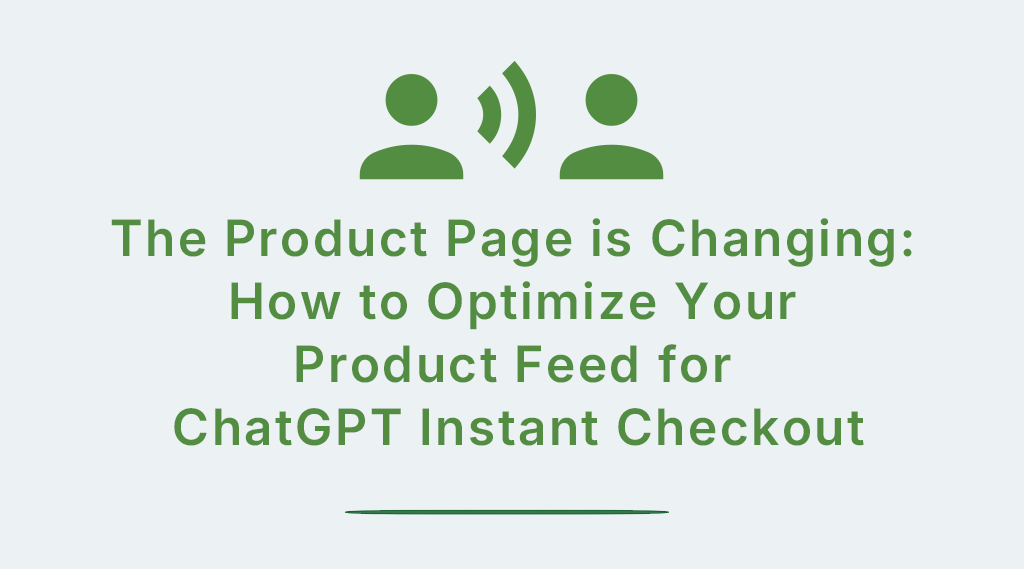ACP and New Shopping Opportunities for Merchants Has Arrived
The buzz around OpenAI, Stripe, and major e-commerce platforms has confirmed it: Agentic Commerce is here. Features like “Instant Checkout” are transforming your product feed from a passive advertising file into your active, transactional storefront. Learn more about Shopify Agentic Commerce here.
At Tadpull, we know the real story is your product data infrastructure.
The cold, hard truth for every brand on Shopify, BigCommerce, or Etsy is this: AI agents will not fix poor product data quality; they’ll expose it by simply ignoring you. If you’re not discoverable by the machine, you won’t appear in the most relevant conversational queries.
The Two Unbreakable Rules of the Agentic Era
- Discovery Runs on Your Feed: Your data is the new SEO. Conversational AI agents, powered by the Agentic Commerce Protocol (ACP), prioritize highly structured, rich, and current data. If your titles, attributes, and pricing are vague or stale, the agent cannot match your product to a precise, nuanced query (e.g., “Find me a men’s waterproof running shoe with strong user ratings and fast shipping”).
- You Remain the Merchant of Record: The ACP is designed to keep you in control of the crucial post-purchase experience (fulfillment, returns, and support). This makes your Catalog Quality and Customer Lifetime Value (CLV) from these channels your greatest competitive moat.
The question is now, “Are we the most relevant and reliable match for specific customer needs?”
The 5-Point E-commerce Platform Audit for ACP Readiness
You don’t need to build a new system; you need to rigorously audit and optimize the data you already have in your existing platform (Shopify, Etsy, BigCommerce, etc.).
🔥 Advanced Tool: Steal our full diagnostic prompt and step-by-step checklist to audit your data
Understanding our P0 / P1 / P2 Grading Rubric
When we talk about P0, P1, and P2 risks, we’re using a severity framework to prioritize product data issues that affect ACP readiness and overall e-commerce performance:
- P0 (Critical / Revenue-Blocking): Showstopper issues that block checkout or get your product suppressed.
- P1 (Material / Eligibility-Limiting): Problems that reduce discoverability or trust but don’t block a transaction.
- P2 (Nice-to-Fix / Optimization): Cosmetic or secondary improvements that polish the experience.
This rubric helps merchants and platform managers triage fixes: P0 issues get immediate attention because they block revenue, P1 issues follow because they impact eligibility and conversion, and P2 issues can be scheduled as ongoing optimization.
1. Economic Integrity: The P0 Risk Zone
An agent optimizes for value and successful checkout. Failure to provide accurate, current cost/price data is a P0 (revenue-blocking) risk.
- P0 Defect: Freshness: Price and availability must be updated near real-time. An update older than 60 minutes for a fast-moving SKU is a P0 risk for ACP freshness.
- Action for Platform Managers: Verify your platform’s integration (e.g., Shopify’s sales channels) is set for automated, near-real-time synchronization of price and inventory to minimize friction and prevent checkout failure.
2. Identity and Attribute Richness: The Semantic Match
Agents match products to highly specific, natural-language queries. Generic titles and missing attributes mean your product is invisible.
- Audit Item: GTIN & Brand Coverage: All active SKUs must have a confirmed Brand and a unique identifier like GTIN/UPC (where applicable). Missing these for even a small percentage of products limits eligibility.
- Action for Product Managers: Go beyond basic fields. Enrich your product descriptions and tags with specific, conversational attributes like use cases (“ideal for red-eye flights”), materials, and key differentiators (“cruelty-free”, “sustainable”).
3. Product Page Structured Data (The New Foundation)
Your product feed is the primary input, but your Product Detail Pages (PDPs) must provide machine-readable backup. Structured Data (JSON-LD Schema.org) is how the AI verifies your claims.
- Must-Have Schemas: Ensure your PDPs include valid, non-duplicated markup for Product, Offer (pricing/availability), and AggregateRating/Review.
- Action for Marketers: Use your e-commerce platform’s built-in SEO tools or a specialized app to implement this structured data. Validate the markup with Google’s Rich Results Test to confirm AI bots can easily parse your price, stock, and rating.
4. Conversational Content & Trust Signals
AI agents value content that is authoritative and easy to cite. They are trained to look for clean, self-contained answers.
- Q&A Format is Key: Structure your descriptions and site FAQs in a Q&A style to match natural user queries (“What are the washing instructions?” or “Is this duvet antibacterial?”). This makes the content highly extractable by the LLM.
- Review Integrity: Agents use high-quality, genuine customer reviews to validate trustworthiness. Ensure review data is correctly surfaced via Review Schema.
5. Purchase Path & Policy Compliance
The final step is proving you are a reliable merchant of record.
- Availability Codes: Your feed must send clear, valid availability status: in_stock, out_of_stock, preorder, or backorder. Invalid or unknown values are a P0 block.
- Policy Links (P1/P0): Ensure every active product is linked to a transparent Returns Policy URL and a clear Shipping Promise. These are non-negotiable trust signals for agents to finalize a transaction.
The brands that win the agentic commerce race are the ones who stop treating product data as a marketing afterthought and start treating it as strategic, high-availability infrastructure. If you are interested in how Tadpull can help, schedule a consultation here!

